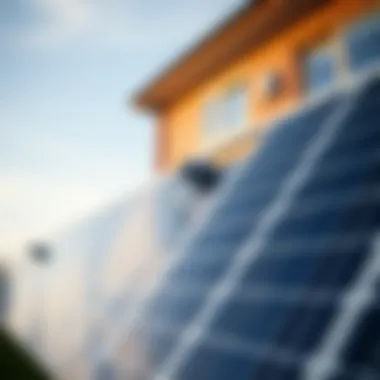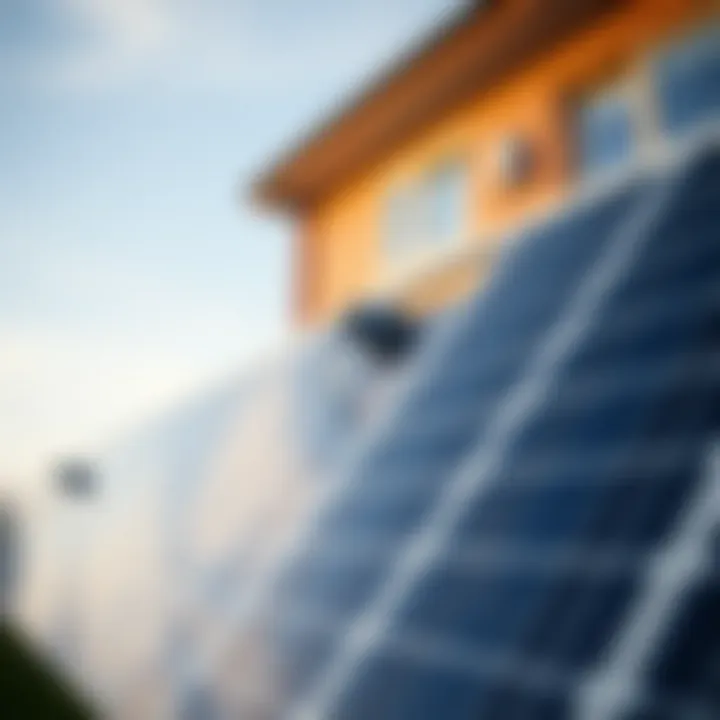Maximizing Solar Energy: Understanding Production Potential


Intro
Solar energy has been gaining a lot of attention lately. As people look for cleaner, sustainable options for their energy needs, solar power stands out as a leading contender. This article aims to dig into the production potential of solar panels—essentially how much energy you can generate with them.
It’s no secret that solar energy comes from the sun, but the intricacies of how solar panels work can be a bit of a puzzle. From the types of solar panels available to the factors that influence their efficiency, we will explore all angles of solar energy production. Moreover, we will touch on financial aspects since the initial investment can be significant.
Arming yourself with the right information can make the transition to solar power more seamless and beneficial. Therefore, whether you’re a newcomer eager to learn about solar energy or a seasoned investor weighing the pros and cons, we have something for you.
Let’s jump into the first section.
Key Terms and Definitions
Understanding a new field often starts with knowing the right terminology. Solar energy production can seem daunting at first, so breaking it down with some essential terms is a good start.
Photovoltaic (PV) Systems
PV systems are what most people think of when discussing solar power. They convert sunlight directly into electricity through solar cells. Whether on rooftops or in large solar farms, PV systems are integral to solar energy production.
Inverter
An inverter is a critical component that transforms direct current (DC) electricity generated by the solar panels into alternating current (AC) electricity, which is what most homes and businesses use.
Solar Irradiance
This term refers to the power of solar radiation (sunlight) received on a certain area. It is a key factor in determining how much energy a solar panel can produce.
Energy Yield
Energy yield is often used to describe the amount of electricity generated by a solar panel over a specific time period. It’s helpful for potential buyers to understand how much they can realistically produce, based on their location and panel quality.
Net Metering
This is a billing arrangement that allows solar panel owners to receive credit for the excess electricity their panels generate and feed back into the grid. It can significantly offset electricity costs.
"The potential for solar energy production is often underestimated, but the key to realizing that potential lies in understanding the enabling technology."
As with any investment, knowing the financial implications is important. Solar energy can save money in the long run, but initial costs can raise eyebrows.
Investment Concepts
When it comes to solar, an initial investment is required. Factors like panel efficiency, installation costs, and ongoing maintenance should all be considered. Understanding these elements helps potential investors assess what kind of return they might expect on their investment.
Financial Instruments
Various financial instruments are available to facilitate the uptake of solar energy. For example, various tax incentives, loans, and grants can reduce the burden of initial costs, creating a more inviting atmosphere for prospective solar panel buyers.
Next, we’ll take a closer look at expert advice that can guide your decision-making throughout your solar energy journey.
Prelude to Solar Energy Production
The topic of solar energy production has become increasingly essential in today's world. With the shift towards renewable resources and concerns around climate change, understanding how solar energy operates can empower individuals and businesses alike. This section provides a foundational overview essential for grasping the energy potential of solar panels. As green energy adoption continues to climb, knowing the ins and outs of solar production isn’t just beneficial; it is necessary.
One of the primary reasons solar energy is turning heads is its accessibility. Gone are the days when solar panels were considered a luxury. Now, they can be installed on rooftops or even in open fields. This leads to a decentralization of power, meaning energy can be generated right where it’s consumed. It’s decentralized because you don't necessarily rely on large power plants or utility companies anymore. And with the right setup, solar energy can reduce electricity bills considerably; who doesn’t want to save a few bucks?
Another significant factor is the sustainability angle. Solar energy is a sustainable resource that helps reduce our carbon footprint. It taps into an abundant supply—the sun itself—unlike fossil fuels that dwindle over time. Each panel installed contributes to a cleaner environment and greener future.
Additionally, understanding solar energy production can open doors for financial opportunities, especially for investors and businesses looking to invest in renewable technologies. It’s not just the energy savings that matter; there are also incentives and tax breaks available that can enhance return on investment significantly.
In short, a thorough comprehension of solar energy production is valuable. It informs choices regarding energy consumption, investment decisions, and broader environmental responsibilities.
The Basics of Solar Power
At its core, solar power involves converting sunlight into electricity. The fundamental technology behind this is the photovoltaic (PV) effect. Solar panels, composed of numerous solar cells, capture sunlight’s energy and convert it into usable electrical energy. This process begins when sunlight strikes the solar cells, releasing electrons due to the interaction of photons with the semiconductor material, typically silicon. Once freed, these electrons create an electric current.
Components that play a role in this conversion include:
- Solar Cells: The workhorses that do the actual converting of sunlight to energy.
- Inverters: Devices that convert the direct current (DC) produced by solar panels into alternating current (AC), suitable for homes and businesses.
- Mounting Systems: Hardware that secures panels on rooftops or other locations, ensuring optimal exposure to sunlight.
The efficiency of solar panels has improved dramatically over the years, with modern technology enabling greater energy capture from less surface area.
Importance of Solar Energy in Today's Context
In our current climate, where environmental degradation is escalating, the importance of solar energy cannot be overstated. It serves as a significant player in the broader discourse on sustainability. As communities and nations aim to reduce greenhouse gas emissions, solar energy provides a viable alternative. According to the U.S. Department of Energy, solar has grown significantly, with a predicted continuing trajectory due to technological advancements and decreasing costs.
Furthermore, adoption of solar power is closely tied to energy independence. By harnessing sunlight, countries can reduce their reliance on imported fossil fuels. This shift not only strengthens national security by limiting exposure to fluctuating market prices but also stabilizes local economies.
Economically, investing in solar energy brings job creation in various sectors—installation, maintenance, research and development. In areas where the solar market flourishes, entire communities can thrive.
Ultimately, solar energy production is not merely an alternative; it’s an essential step toward a responsible energy future. By understanding its intricacies now, readers can prepare to harness its benefits, both for themselves and for the planet.
"The sun is the most powerful source of energy on Earth, and tapping into it is one of the best decisions we can make for our energy needs."
To delve deeper into solar energy's potential, visit reputable resources such as Wikipedia on Solar Energy or the U.S. Department of Energy's Solar Page.
Optimizing energy production through solar panels can transform both home energy use and national energy policies. This overview sets the stage for a detailed exploration of how solar panels generate energy, influencing factors, and much more.


How Solar Panels Generate Energy
Understanding how solar panels generate energy is crucial for both potential buyers and those keen on renewable energy. This section will break down the inner workings of solar panels and highlight why this technology stands out in the green energy sector. It’s not just about saving money on your electricity bills; it’s about making a substantial impact on the environmental landscape.
The Photovoltaic Effect Explained
At the heart of solar energy generation lies the photovoltaic (PV) effect. This refers to the process where sunlight is converted directly into electricity. When light photons hit a solar panel, they excite electrons within semiconductor materials, typically silicon. This excitation causes the electrons to move, creating an electric current.
This process is what truly empowers solar panels. Unlike other forms of energy generation, which often involve considerable environmental impacts, harnessing sunlight through the PV effect is comparatively clean. The more sunlight that strikes the panel, the more electricity it generates, which makes understanding this effect essential for optimizing energy production.
Components of a Solar Panel System
A solar panel system isn't just the panels themselves—it’s a complex assembly of components working in unity to convert solar energy into usable electricity. Let's explore the key elements of these systems:
Solar Cells
Solar cells are the backbone of any solar panel. Made mainly from silicon, they convert sunlight directly into electricity through the photovoltaic effect. The main characteristic that sets solar cells apart is their efficiency. Monocrystalline cells, for instance, are known for their high efficiency ratings, often reaching above 20%. This efficiency translates to greater electricity output from a smaller amount of space, making them particularly appealing for both residential and commercial use.
The unique feature of monocrystalline solar cells is their uniform color and shape, which not only enhances aesthetics but also maximizes surface area absorption. However, one drawback is that they tend to be pricier compared to their polycrystalline counterparts. In balancing cost and efficiency, homeowners must consider their unique situations when choosing solar cells.
Inverters
Until now, we understand that solar panels convert light into direct current (DC). However, households and businesses typically utilize alternating current (AC). This is where inverters come into play. Their job is to convert the DC generated by the solar panels into AC for everyday use.
A standout feature of inverters is their ability to monitor the performance of each solar panel in a system. This means potential issues can be identified quickly, improving efficiency over time. There are string inverters, which serve multiple panels, and microinverters, which operate on a panel-by-panel basis. While microinverters can bring more output from individual panels, they often bear a higher initial cost.
Mounting Systems
The mounting system may seem like a minor component, but it’s critical for the longevity and performance of solar panels. These systems secure the panels in place and allow for optimal positioning to capture sunlight. Whether flush-mounted or elevated, they also define the angle at which your solar panels catch the sun.
The central characteristic here is durability against weather conditions, such as strong winds or heavy snow. High-quality mounting systems are made from materials like aluminum or stainless steel, resisting corrosion and increasing lifespan. One downside is that improper mounting can lead to subpar performance—or even damage—so correct installation becomes paramount for success.
"The efficiency of your solar panels is only as good as the sum of their parts. Each component plays an integral role in the overall production of energy."
As you delve deeper into the world of solar energy, grasping how these components fit together can empower you to make more informed decisions. Each element has its roles, strengths, and limitations, influencing overall solar energy production. With such knowledge, both novices and seasoned investors can approach solar projects with confidence.
Factors Affecting Solar Energy Output
Understanding the nuances of solar energy production goes beyond just having panels installed on the roof. Several key factors influence how much energy a solar panel system can generate. Each element plays its part in maximizing efficiency and ultimately impacts the return on investment for homeowners and businesses alike. If you're considering solar panels, understanding these factors will not only help you estimate production but also guide you in making informed decisions regarding your solar energy system.
Geographical Location
The geographic placement of your solar installation is crucial. Areas closer to the equator receive more sunlight throughout the year compared to regions further north or south. For instance, a solar panel system in Arizona will likely produce more energy than the same setup in Washington due to differences in solar irradiance.
Consider these elements:
- Sunlight Exposure: Regions with long sunny days have a natural advantage.
- Altitude: Higher elevations often experience less atmospheric interference, enhancing sunlight penetration.
- Latitude: Different angles of the earth’s tilt affect solar potential year-round.
In essence, knowing your geographical context allows you to effectively gauge the efficiency of your solar systems. It’s no secret that resource optimization starts with location.
Weather Conditions
Weather plays a pivotal role in solar energy generation. Just like a plant needs sunlight but can be hindered by overcast skies or heavy rain, solar panels can be impacted by similar conditions. Consistent cloud cover can reduce energy production significantly. Here's what you should keep in mind:
- Temperature: Interestingly, solar panels work more efficiently at cooler temperatures. Excessive heat can lead to lower energy outputs.
- Precipitation: Rain can be beneficial, as it cleans the panels but constant rainfall can reduce output.
- Snow and Ice: While snow can block sunlight initially, it must be said that panels can actually perform well when snow melts off due to the reflection of sunlight.
In summary, the weather conditions in your area should be a consideration when determining the viability of solar panels for energy production.
Panel Orientation and Tilt
The angle and direction of your solar panels are game changers in the energy production equation. A well-tilted solar panel captures sunlight more effectively than those installed flat.
Key considerations include:
- Orientation: Facing panels south (in the Northern Hemisphere) generally optimizes sun exposure.
- Tilt Angle: The angle should be adjusted based on your geographic latitude. A standard range is typically between 30 to 45 degrees. Customizing the tilt can maximize exposure to the sun relative to its position in different seasons.
Utilizing tools like solar pathfinders or software simulations can help determine the best setup for your specific conditions.
Shading and Obstructions
Even the mightiest solar panels can be left in the shadows—quite literally—by trees, buildings, or any other objects that might block sunlight. This is where planning and foresight come into play. Key points to consider:
- Permanent Shading: Decide where you install your panels. Avoid areas where obstructions, like tall buildings or structures, will cast shadows during peak sunlight periods.
- Seasonal Variability: Trees might not shade panels in summer but could block sunlight in the winter when the sun is lower on the horizon.
- Technological Solutions: Microinverters or power optimizers can help mitigate the impacts of partial shading on panel arrays.
In short, ensuring your solar panels are free from obstructions is crucial for maximizing potential energy production.
Solar energy has immense potential, but understanding its influences is the key to harnessing it successfully.
By keeping these factors in view, you can better predict and enhance the efficiency of your solar installations. This knowledge equips you to make educated decisions tailored to your unique situation.
Types of Solar Panels and Their Efficiency
Understanding the types of solar panels and their efficiency is crucial in making a sound decision when investing in solar energy. This section will break down the three main types of solar panels: monocrystalline, polycrystalline, and thin-film. Each type has unique characteristics, advantages, and considerations that can significantly impact the energy output and overall cost-effectiveness of a solar panel system. Knowing the differences helps potential users to choose wisely based on their specific needs and circumstances.
Monocrystalline Solar Panels


Monocrystalline solar panels are often recognized for their high efficiency and sleek aesthetics. They are made from a single crystal structure of silicon, which typically leads to greater energy conversion rates. These panels are more space-efficient, which means they generate more power per square foot compared to other types.
The primary advantages of monocrystalline panels include:
- Higher efficiency: These panels can reach efficiency rates above 20%, meaning more electricity from less space.
- Longevity: They tend to have a longer lifespan, often around 25 years or more, reflecting their durability.
- Better performance in heat: Monocrystalline panels perform better in high temperatures, making them ideal for warmer climates.
However, they also come with some drawbacks:
- Cost: These panels usually carry a higher price tag, making the initial investment steeper.
- Brittleness: They can be more prone to damage compared to other types if not handled correctly.
Polycrystalline Solar Panels
Polycrystalline solar panels are made from multiple silicon crystals and are generally less efficient than their monocrystalline counterparts. However, they still provide a solid return on investment, particularly for homeowners with larger roofs where space is not a primary concern.
Key benefits of polycrystalline panels are:
- Lower cost: They are usually cheaper to produce and purchase, making them more accessible for many consumers.
- Less energy waste: While they are less efficient, they convert sunlight into electricity reasonably well, particularly in moderate temperature environments.
Yet, there are considerations to bear in mind:
- Less efficient: Efficiencies typically range between 15% and 18%, meaning you need more space for the same power output.
- Performance in heat: They tend to perform slightly worse in high heat compared to monocrystalline panels.
Thin-Film Solar Panels
Thin-film solar panels represent a newer technology in the solar market. These panels are made by depositing a thin layer of photovoltaic material onto a substrate, allowing for more flexibility in design and installation.
Pros to consider for thin-film panels include:
- Lightweight and flexible: Their lightweight nature means they can be installed on a broader range of surfaces and structures.
- Lower production costs: Generally less expensive to produce, making them an appealing option for large-scale projects.
Drawbacks might be significant as well:
- Lower efficiency: Efficiency rates hover around 10% to 12%, so larger installations are usually required to generate the same amount of energy as other types.
- Shorter lifespan: Often, they have a shorter lifespan, averaging around 10 to 20 years.
"Solar energy is a real game-changer; choosing the right panels is key to harnessing its full potential."
For more information about solar panels and their efficiency, you can visit Wikipedia or check out resources available at Energy.gov.
Calculating Solar Energy Production
Calculating solar energy production is a key area of focus in understanding how much power you can generate with solar panels. This topic is pivotal not only for residential users but also for commercial investors who wish to maximize benefits while minimizing costs. When you get a handle on solar energy production, you can make informed decisions regarding panel installation and energy usage. Before one jumps into the calculations, it's essential to grasp that accurate estimates of solar output derive from various factors that interact in unique ways depending on geographical location, weather, and more.
Understanding Solar Panel Ratings
To grasp how much energy a solar panel can produce, one must first understand solar panel ratings. Rating is primarily expressed in watts, indicating the maximum power output under specific conditions, usually ideal lab conditions (also referred to as STC – Standard Test Conditions).
Typically, panels are rated anywhere from about 250 watts to 400 watts. Higher wattage ratings often mean faster energy generation, which can be crucial in maximizing energy savings by shortening the payback period. However, ratings alone do not paint the whole picture. It's wise to factor in efficiency, which shows how well a panel converts sunlight into usable electricity.
- Monocrystalline Panels tend to have higher efficiency (up to 22%) and usually command a higher price.
- Polycrystalline Panels, on the other hand, might offer slightly lower efficiency at about 15-20% but tend to be more budget-friendly.
In choosing among the various kinds, understanding how these ratings play into your overall energy needs is vital.
How to Estimate Your Energy Needs
Estimating your energy needs involves an evaluation of your current consumption patterns alongside the energy generation potential of your proposed solar panel system. The first step here is to look at your previous utility bills. Most bills indicate how much energy you used over a month.
Here's a simple way to go about estimating:
- Record your total monthly energy usage in kilowatt-hours (kWh).
- If you’re aiming for net-zero energy, your solar panel system should ideally generate this much energy annually.
- Divide this annual figure by 12 to find the average monthly generation required.
Calculating energy needs is often more than mere numbers. It includes assessing your lifestyle, considering future electrical demands, and potential energy-saving measures you might adopt.
Using Solar Production Calculators
An invaluable tool for those looking to harness solar energy lies in solar production calculators. These tools simplify the complexities involved in estimating energy production. To use a calculator effectively, you typically need to input:
- Your location (to determine solar irradiance)
- The angle and orientation of the panels
- The type of solar panels you plan to use
- Your estimated energy needs.
Most of these calculators utilize extensive databases to provide a more tailored estimate. Two popular examples include the calculators found on websites like PVWatts and the Solar-Estimate.org. They’re particularly useful for comparing various configurations and can give you a ballpark figure of what to expect. They can also help in understanding returns on investments, guiding your acquisition decisions.
"Accurate solar energy estimation can be the difference between a good investment and a great one."
In summary, calculating solar energy production involves understanding the ratings of solar panels, estimating your energy needs based on historical usage, and using the right tools like solar production calculators. Each of these elements plays an integral role in creating a clearer picture of what your solar power generation might look like.
Case Studies of Solar Energy Production
Examining case studies of solar energy production showcases the real-world implications of solar technology, illuminating the diverse experiences and outcomes that can arise from adopting solar solutions. Understanding these examples is essential as it provides insights into practical applications, financial impacts, and the effectiveness of solar energy systems across different settings. By taking a closer look at these cases, readers can grasp not only the potential of solar panels but also the challenges and benefits that come with their deployment.
Residential Solar Installations
Residential solar installations have gained considerable traction in recent years as individuals seek to harness solar energy to combat rising electricity costs and reduce their environmental footprint. Homeowners often find that investing in solar panels brings about significant savings in the long run. However, what truly matters in these cases is how each installation story differs based on location, panel choice, and specific energy needs.
For instance, consider a suburban home in sunny California. The residents decided to install monocrystalline solar panels, taking advantage of the ample sunlight in their region. After conducting a detailed assessment, they learned that their energy consumption was substantial due to high air conditioning use during peak summer months. Therefore, opting for high-efficiency panels enabled them to generate enough energy to power their home, resulting in a dramatically reduced electricity bill.
Moreover, these homeowners could also utilize various financial incentives, such as the federal solar tax credit, further enhancing their return on investment. Recouping their costs faster than anticipated changed not only their energy narrative but also contributed positively to the environment.


Conversely, let’s look at a family in the Pacific Northwest, an area more characterized by cloudy weather. While they wanted to embrace solar energy, the cloudy conditions impacted their energy production potential. Here, they chose thin-film solar panels, which are known to perform slightly better in partial shade compared to other types. While they did not achieve the same savings as the family in California, they still found a significant drop in their energy costs, reaffirming that solar energy can still be viable in less-than-ideal conditions.
What these stories illustrate is that solar solutions are not one-size-fits-all. Factors such as climate, local laws, and financial resources play a significant role in determining the true effectiveness and feasibility of residential solar installations. Homeowners considering these options must evaluate their unique situations to make informed decisions regarding their solar investments.
Commercial Solar Solutions
In the commercial sector, the stakes are often higher, and the financial implications of solar energy production can be profound. Businesses face the dual pressure of minimizing expenses while also being scrutinized for their environmental impact. A compelling case study is a large grocery chain in Texas that invested in a substantial solar project to enhance its sustainability profile and save on energy bills.
The organization leased space on the rooftops of several stores for solar installations. After conducting detailed energy audits, they recognized that the energy generated could cover a significant portion of their operational costs. They installed polycrystalline solar panels, finding them both cost-effective and efficient for their use case. Consequently, not only did they witness a reduction in electricity costs, but they also enhanced their brand image as a leader in environmental responsibility.
In a different scenario, a manufacturing company in the Midwest opted to install solar panels on the land they owned, creating a solar farm. Their motivation stemmed from a desire to diversify energy sources and reduce dependence on traditional electricity providers. Over time, they learned that the energy generated not only powered their manufacturing facility but also enabled them to sell surplus energy back to the grid, creating a new revenue stream. This dual benefit highlighted the dynamic potential of solar energy in commercial applications.
While economic incentives, such as rebates and tax credits, exist for commercial solar projects, companies must also be attentive to regulatory requirements. The journey often requires collaboration with local governments and energy providers to ensure compliance and maximize benefits. In both cases, the importance of a tailored, strategic approach to solar adoption becomes clear, highlighting how diverse commercial environments can significantly influence solar energy production outcomes.
By navigating case studies and analyzing various installations, prospective solar investors can obtain a clearer picture of what solar energy can realistically offer. Numerous experiences abound, showing that while challenges might arise, the potential benefits of adopting solar solutions often overshadow the obstacles.
Financial Considerations of Solar Energy
The financial aspect of solar energy is often what stops potential adopters in their tracks, though it can also be what ultimately drives them to invest in solar technology. Understanding the cost versus benefit dynamic is crucial for anyone considering this alternative energy route. By harnessing solar energy, individuals and businesses alike can look forward to a better financial future with potential savings and incentives from the government.
Initial Investment and Long-Term Savings
Making the leap into solar energy typically starts with a hefty initial investment. The cost of solar panel installation can vary widely, depending on several factors, including the size of the system, the type of panels chosen, and the installation contractor's fees.
Even with the costs upfront, it's important to view this as an investment rather than just an expense. Once installed, solar panels can drastically lower utility bills, providing savings that accumulate over time. Once you factor in the lifespan of solar panels—typically around 25 to 30 years—the potential for long-term savings becomes clear. For instance, a residential installation might lead to annual savings of thousands over the lifetime, ultimately covering the initial investment and even providing financial gain long after.
Here are some key points about initial costs and long-term savings:
- Equipment Costs: Solar panels, inverters, and mounting structures are your main costs. Quality varies, and it's wise to research what works best for your circumstances.
- Installation Prices: Not all installers will charge the same. It's beneficial to get multiple quotes and ensure the installer has good reviews and experience.
- Return on Investment (ROI): Calculate how long it will take to recoup your initial investment through energy savings. Many see ROI within 5 to 10 years anymore.
Incentives and Tax Credits
To sweeten the pot, various incentives and tax credits are available at both the federal and state level. These can significantly reduce the overall cost of going solar. The federal solar tax credit allows you to deduct a percentage of the solar installation costs from your federal taxes. This offer currently stands at 26%, a significant boost to financial feasibility for many households and businesses.
In addition to federal incentives, many states and localities offer their own bonuses, such as sales tax exemptions and rebates for installing solar systems. Consider these benefits:
- State Rebate Programs: Check if your local government offers cash rebates for solar. These can sometimes cover a considerable chunk of the costs.
- Net Metering: Many states have net metering laws that allow homeowners to sell back excess energy to the grid, further offsetting costs and optimizing savings.
- Grants and Subsidies: Some regions offer grants designed to support solar installations, easing financial burdens for lower-income households.
Researching available incentives and understanding your eligibility is crucial. With these financial considerations in mind, you might find that the journey to solar is not just an idealistic choice for the environment, but also a savvy economic decision.
Sustainability and Environmental Impact
In today's world, the discussion around sustainability has never been more imperative. The push for renewable energy sources, such as solar power, stems not just from economic desires but from an understanding that our planet's resources are finite. Solar energy stands out as a key player in the shift toward a more sustainable future. Its capacity to generate power without depleting natural resources or producing harmful emissions makes it a cornerstone of modern environmental strategy.
Most critically, solar panels offer a way to reduce our reliance on fossil fuels. As they harness sunlight, they prevent the release of carbon dioxide and other greenhouse gases, thus contributing directly to a decrease in global warming. This reduction in our carbon footprint is not merely beneficial but crucial; reducing emissions mitigates severe weather events, protects biodiversity, and ultimately reduces health risks associated with air pollution.
Reduction of Carbon Footprint
A clear benefit of solar energy is its prominent role in reducing the carbon footprint of households and businesses. By shifting to solar, one can avoid the fossil-fuel-generated electricity that contributes heavily to carbon emissions. For instance, the average residential solar panel system can offset around 3,000 to 4,000 pounds of carbon dioxide each year. Here’s what this means:
- Local Benefits: Each household that switches to solar helps improve air quality locally. Cleaner air means healthier communities.
- Global Impact: On a larger scale, a significant transition to solar could help reverse some damage done to our ozone layer and bring the planet back into balance.
- Future Generations: By reducing today’s emissions, future generations are given a better chance at a stable climate, ensuring resources that were neglected in the past continue to thrive.
In fact, some studies suggest that if solar energy expands significantly, we could see a decrease in global temperature rise, pushing humanity toward a future that is not only sustainable but harmonious with nature.
Lifecycle Analysis of Solar Panels
When discussing the sustainability of solar energy, it is essential to look beyond initial benefits and consider the full lifecycle of solar panels. From manufacturing to eventual disposal, each phase carries its own environmental impacts. A lifecycle analysis (LCA) serves as a valuable tool to understand these impacts.
- Manufacturing Phase: Solar panels require raw materials, primarily silicon, which are mined and processed. This first step does involve energy usage and environmental disruption, yet advances in technology are making this process cleaner.
- Usage Phase: Once installed, solar panels can produce clean energy for over 25 years with minimal maintenance. The energy produced far outweighs the energy used in their production in just a few years.
- End-of-Life: Disposal or recycling of solar panels has become a focus, as improper disposal could lead to waste issues. However, many parts of a solar panel can be recycled, lessening the need for raw material extraction.
"Understanding the full lifecycle of solar panels helps us see not just their immediate benefits but their potential in contributing to sustainable practices over decades."
By evaluating each phase of solar power's lifecycle, we garner a clearer picture of its overall impact and can make informed decisions that enhance sustainability efforts. As technology evolves, efforts focus on improving these systems. For instance, research into bifacial solar panels and recyclable materials showcases a commitment to minimizing environmental impact at every turn. This comprehensive analysis allows us to advocate for solar energy not just as a clean alternative, but as a fundamental element of a sustainable future.
Enhancing our understanding of entry points into solar technology allows both seasoned investors and new adopters to appreciate the broader environmental implications of their energy choices. For those looking to integrate solar panels into their lives, the journey extends beyond installation; it branches into a commitment toward sustaining our environment for future generations.
For further in-depth understanding, visit: Wikipedia on Solar Power, or check out National Renewable Energy Laboratory.
Engaging with this emerging technology not only fosters individual and community resilience but serves a larger purpose—to create a cleaner, brighter future for all.
The Future of Solar Energy Production
As we advance deeper into the 21st century, the conversation around solar energy continues to evolve dramatically. This section highlights the potential pathways solar energy production may take in the near future, coupled with the implications of these developments for both individuals and investors. With increasing global emphasis on sustainability, transitioning to renewable energy sources such as solar is not just a trend—it's becoming essential. Understanding where solar technology is headed can provide insight into its viability as a primary energy source.
Technological Innovations
The progression in solar technology is nothing short of fascinating. High-efficiency solar cells, such as those made from perovskite, are being developed to outperform traditional silicon cells. These innovations are not just lab talk; they are being rolled out and tested in various settings. Here are some key advancements to keep an eye on:
- Bifacial Solar Panels: These panels capture sunlight from both sides, significantly enhancing energy generation.
- Building-Integrated Photovoltaics (BIPV): Imagine solar panels seamlessly integrated into the architecture of buildings, acting both as a power generator and a design element.
- Solar Tracking Systems: These systems adjust the panels' angles throughout the day to maximize sunlight capture.
"As solar panel efficiency increases, the prospect of solar energy covering a larger share of our energy needs becomes increasingly achievable."
Such innovations are not only about improving energy efficiency; they are also about making solar power more accessible and practical in everyday situations. These developments potentially lower costs and speed up the adoption of solar energy, opening a door for broader market penetration.
Integration with Energy Storage Solutions
The relationship between solar energy generation and energy storage solutions cannot be dismissed. As solar energy's share in our overall energy mix increases, the need for effective storage methods surges. While solar panels generate electricity during the day, energy storage systems, like lithium-ion batteries, allow that energy to be stored for use when the sun isn’t shining, such as at night or during cloudy days. This integration offers several advantages:
- Increased Energy Independence: Households can store excess energy instead of relying solely on the grid, translating to lower utility bills.
- Mitigation of Peak Demand: Stored energy can relieve pressure on the grid during high-demand periods, which is crucial for system stability.
- Greater Reliability: Energy storage enhances the reliability of solar power, making it a more appealing option for both consumers and large-scale energy providers.
Governments and companies are investing heavily in developing more efficient battery technologies and systems to support this trend. Innovations in this sector are seen as a critical stepping stone for realigning how we think of energy consumption, paving the way for a future where solar can be a reliable player in a diversified energy landscape.
As we foresee the future of solar energy production, it seems the sky's the limit for its potential applications and benefits. With advancements in technology and the rising capability of energy storage solutions, solar energy is not just a fleeting phase but a cornerstone of sustainable energy strategies for years to come.







